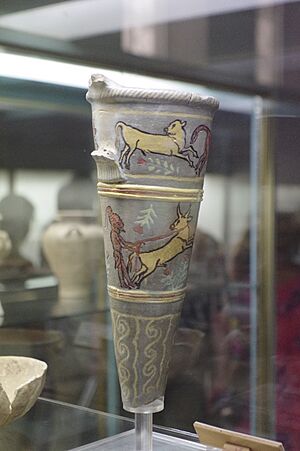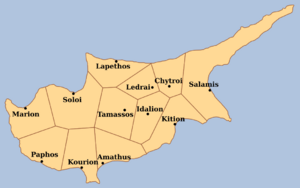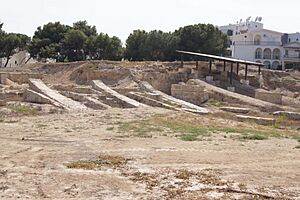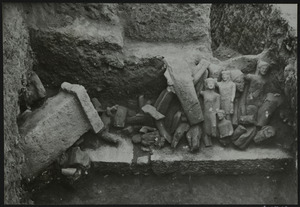Kition facts for kids
Quick facts for kids
Kition
𐤊𐤕 or 𐤊𐤕𐤉
Κίτιον |
|
|---|---|
| 12th century BC–342 AD | |

Location of Kition
|
|
| Capital | Kition |
| Common languages | Greek and Phoenician |
| Religion | Ancient Greek religion and Phoenician religion |
| Government | City-kingdom |
| Historical era | Classical Antiquity |
|
• Established
|
12th century BC |
|
• Disestablished
|
342 AD |
| Currency | Stater, obol |
| Today part of | Cyprus |
Kition was an ancient city-kingdom on the southern coast of the island of Cyprus. For many centuries, it was an important city for both ancient Greeks and Phoenicians. Today, the modern city of Larnaca is located where Kition once stood.
Kition was one of the Ten city-kingdoms of Cyprus. A city-kingdom was like a small country, with its own ruler and government, all centered around one main city.
Contents
Name
The city's name, Kition, came from the name used by the Phoenicians who settled there. The ancient Greeks later called it Kition, and the Romans called it Citium. The famous philosopher Zeno of Citium was born here.
History of Kition
The story of Kition is very long, with different groups of people living there and ruling the city over time.
Early Greek Settlers
Around the 1200s BC, during the Late Bronze Age, Mycenaean Greeks settled in the area. They came to mine the rich copper resources found on Cyprus. This first settlement was destroyed around 1200 BC but was quickly rebuilt.
The new town was bigger and stronger. Instead of simple mudbrick walls, it was protected by cyclopean walls, which were made from huge, massive stones.
The Arrival of the Phoenicians
Beginning in the 10th century BC, Phoenician traders from the powerful city of Tyre began to settle in Kition. The Phoenicians were expert sailors and merchants. They expanded the city and made it an important trading hub. They also rebuilt the city's temples for their own gods.
Rule by Great Empires
Because Cyprus was in a strategic location, many powerful empires wanted to control it. For centuries, Kition was ruled by different foreign powers.
- Egyptian Rule: From 570 to 545 BC, Kition was under the control of Egypt.
- Persian Rule: In 545 BC, the Persian Empire took over Cyprus. The kings of Kition were allowed to rule, but they had to obey the Persians.
- Greek and Roman Rule: In 332 BC, Persian rule ended. Later, in 312 BC, the Greek general Ptolemy I conquered Cyprus. He ended the rule of the Phoenician kings of Kition. Finally, in 58 BC, Cyprus became part of the Roman Empire.
The End of the City
Kition was a successful city during Roman times. However, it suffered from very strong earthquakes in 322 and 342 AD. These earthquakes caused so much damage that Kition, along with other Cypriot cities like Salamis and Paphos, was destroyed and eventually abandoned.
What Archaeologists Found
The ruins of Kition are located in the modern city of Larnaca. Archaeologists have been digging there for over a hundred years to uncover the city's secrets. The first major excavation was done by the Swedish Cyprus Expedition in 1929.
The Kathari Site: A Place of Temples
This area, about 500 meters from the coast, was the main religious center of Kition. Excavations here uncovered:
- Parts of the city's defensive walls from the 13th century BC.
- The remains of five different temples. The largest temple was huge, measuring 35 meters by 22 meters.
- The temples were built with large, carefully cut stone blocks known as ashlar masonry.
The Bamboula Site: A Harbor and Sanctuary
This site is located closer to the sea, where the ancient harbor once was.
- The Phoenician Harbor: One of the most amazing discoveries here was the Phoenician harbor for warships, built in the 5th century BC. It had special buildings called ship sheds, where ships like triremes could be pulled out of the water to be stored and repaired.
- Sanctuaries: Archaeologists also found sanctuaries (holy places) dedicated to the Phoenician goddess Astarte and the god Melqart. The god Melqart was often identified with the Greek hero Heracles.
In 2016, a fantastic discovery was made nearby. While workers were fixing a sewer pipe, they found a 20-meter-long Roman mosaic. The mosaic shows the "Labours of Hercules," a series of famous adventures by the Greek hero.
Tombs and Other Discoveries
Many other important things have been found at Kition.
- Tombs: Several underground tombs, called hypogea, have been discovered. These were elaborate burial chambers for important people.
- The Sargon Stele: In 1845, a large stone slab covered in writing was found. This is the Sargon Stele, which tells of the conquest of Cyprus by an Assyrian king in the 8th century BC.
- Residential Areas: Archaeologists also found parts of the city where regular people lived, giving us clues about their daily lives.
Images for kids
See also









